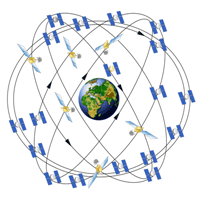The Air Force is slowing GPS modernization and dropping part of the funding for dual launch of satellites, said defense officials describing the President’s Fiscal Year 2015 (FY15) budget on Wednesday (March 5, 2014).
Air Force Undersecretary Eric Fanning said the Air Force would continue to “honor our investments and obligations” regarding the Global Positioning System but would “reprofile” the GPS III program so that it meets constellation sustainment demands.
The Air Force is slowing GPS modernization and dropping part of the funding for dual launch of satellites, said defense officials describing the President’s Fiscal Year 2015 (FY15) budget on Wednesday (March 5, 2014).
Air Force Undersecretary Eric Fanning said the Air Force would continue to “honor our investments and obligations” regarding the Global Positioning System but would “reprofile” the GPS III program so that it meets constellation sustainment demands.
“The issue there was the satellites lasted longer than we expected, said Maj. Gen. Robert McMurry, the Air Force’s director of space programs. “The GPS program procurement rate was a little bit faster than we needed (and) we were under pretty strong budget pressure for options. And so, while we would probably have a more efficient buy profile if we bought them at the rate we had planned, we decided we could delay that purchase rate, still meet the requirements for the on-orbit constellation . . . and at the same time save funding requirement that we needed in [the Future Years Defense Program].”
The overall delay in procurement will mostly affect space vehicles 9 (SV9) and beyond and SV8 should go on contract within the next few months, McMurry said. “Instead of buying 2, 2, 3, 3, 3 [satellites per year], I think we are buying 1, 1, 3, 3, 3,” he explained. “We’re just slowing down the number of them that we’re buying.”
According to the Air Force’s “Program Acquisition Cost by Weapon System” document for next fiscal year, the FY15 budget will fund procurement for GPS III SV9 and advance procurement for SV10.
The delivery of first GPS III satellite will slip to fiscal year 2016, McMurry said.
“We’ll pay a unit price that is a little higher,” with the delays, explained Deputy Air Force Under Secretary for Space Troy Meink, “but just like when you buy your car on payments, you pay more for the car, but you have cash flow management.”
The delay saves money beyond the cost of the satellites themselves, pointed out Meink; the Air Force also saves the cost of lifting them into space. “It’s kind of a 2-for-1 impact.”
When those GPS satellites are eventually launched, they will be less likely to be going up two at a time. Alhough there had been a push to move to dual launches for GPS, the FY15 budget does not have money to fund development of the launch vehicle capability to carry two spacecraft.
“We had previously funded dual launch in the launch line saying we were going to develop that as a [United Launch Alliance, a Lockheed/Boeing joint venture] capability. We have subsequently removed funding for that,” said McMurry. “The expectation is that . . . in the near term it is not as critical, given the lower replenishment rates that we have for GPS.”
A possibility remains, he said, that ULA may choose to develop dual-launch capability on its own. If it does, the GPS program will be able to take advantage of it, as the Air Force will keep funding the technology needed on the satellites for dual launches.
“We have maintained the development of dual-launch capability within the satellite line,” McMurry told reporters at a briefing on the Air Force’s space program. “The satellite itself will have the dual transponders and radio frequencies in place so that, if you launch two of them together, you could communicate with both of them independently.”
The plans, which are based on the assumption that federal budget “sequestration” will not reemerge in 2016, would have to be readjusted if more cuts are required, said Fanning. GPS III, he said, would be one of three air Force space program targeted for more cuts, and the Air Force would not be able to buy one of the three GPS III satellites now planned for procurement in FY17.
The delays, he pointed out could “add increase to the overall cost.”
The fundamental reason for the FY15 cuts, however, said Meink, is that the constellation is currently working well.
“We have a very healthy [GPS] satellite constellation,” said Meink. “Satellites are living longer than we predicted. So, we didn’t need to replenish them as fast as we originally planned, and it made no sense to spend that money if we didn’t need the satellites.”






